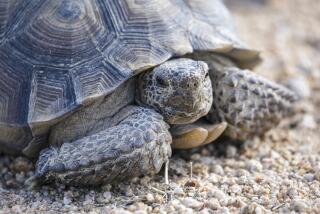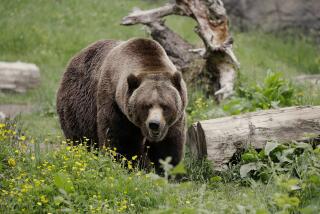Imperiled bird, the greater sage grouse, is key to land preservation plan
- Share via
The greater sage grouse once numbered into the millions, but its population has shrunk to no more than hundreds of thousands as human developments have expanded across 10 western states.
Now, the fate of the imperiled bird, is at the center of a battle over to how to manage sagebrush lands that have long been the symbol of the West.
The Obama administration this week announced its latest proposals to protect the grouse by limiting some development and restricting some types of drilling for oil or gas on the lands run by the U.S. Bureau of Land Management and the U.S. Forest Service.
At the heart of the battle is a court-ordered deadline of Sept. 30 for the federal government to decide whether the sage grouse needs protection under the Endangered Species Act.
That designation could limit energy-related development even more than the administration proposals.
At stake is the Sagebrush Sea, millions of acres of grasslands across California, Colorado, Idaho, Montana, Nevada, North Dakota, Oregon, South Dakota, Utah and Wyoming.
More than two dozen varieties of the grasses grow in the region, home to more than 300 animal and bird species, including the sage grouse.
It is a region under stress.
“The West is rapidly changing — with increasingly intense wildfires, invasive species and development altering the sagebrush landscape and threatening wildlife, ranching and our outdoor heritage,” said Interior Secretary Sally Jewell. “As land managers of two-thirds of greater sage grouse habitat, we have a responsibility to take action that ensures a bright future for wildlife and a thriving Western economy.
“Together with conservation efforts from states and private landowners, we are laying an important foundation to save the disappearing sagebrush landscape of the American West,” she said as she unveiled the proposals Thursday at the Hereford Ranch east of Cheyenne, Wyo.
Jewell tried to minimize the expected complaints from environmental groups seeking tougher regulations and from energy producers seeking to ease restrictions.
The plans “have strong conservation efforts, but they also allow sustainable development and traditional uses of the land,” Jewell said. “And they respect the existing rights that exist on these lands.”
Environmental groups were cautious, with some urging more stringent protections.
“This planning process definitely has the potential of finally conserving a quintessential American species and landscape, but half-measures won’t cut it,” Jamie Rappaport Clark, president and chief executive of the Defenders of Wildlife, said in a prepared statement.
Erik Molvar, a wildlife biologist with WildEarth Guardians, said the proposals were not strong enough.
“The Interior secretary went to a part of Wyoming where the sage grouse has been extinct for decades to circle her wagons around a crippled Wyoming plan,” he said.
He argued that the federal plan would allow more energy-related development.
Energy groups also were unhappy with the federal proposals.
“Conservation of the sage grouse is a goal shared by the oil and natural gas industry, ranchers, other industries, states and communities across the West,” said Kathleen Sgamma, vice president of government and public affairs at Western Energy Alliance, a trade group that represents 450 energy-related companies. “That goal is best achieved at the state level, not with a one-size-fits-all federal approach.”
Some Republicans in Congress criticized the plans as the federal government reaching too far.
“This is just flat out wrong,” Rep. Rob Bishop of Utah, chairman of the House Natural Resources Committee, said in a statement. “If the Administration really cares about the bird they will adopt the state plans as they originally said they would. The state plans work. This proposal is only about controlling land, not saving the bird.”
@latimesmuskal
More to Read
Sign up for Essential California
The most important California stories and recommendations in your inbox every morning.
You may occasionally receive promotional content from the Los Angeles Times.











